Learn how to can beef stew, with beans, potatoes, carrots, etc. for long term storage, using a pressure canner. Enjoy this hearty stew year round! 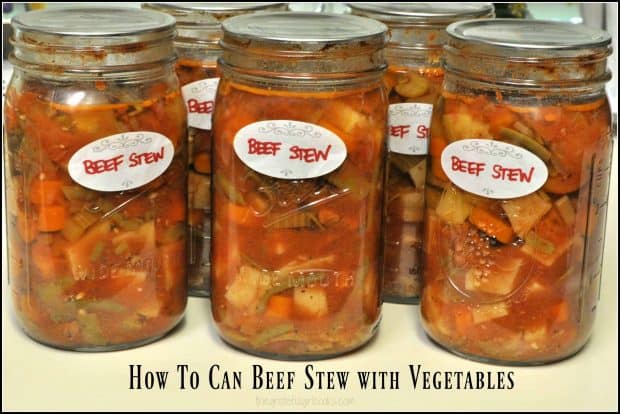 It’s the middle of Summer, yet I find myself mentally preparing for the Oregon Fall and Winter ahead. I decided to get a jump on the cold, rainy weather and get some canned goods ready. Here’s how to can beef stew with vegetables…jars of yummy stew… now in our pantry!
It’s the middle of Summer, yet I find myself mentally preparing for the Oregon Fall and Winter ahead. I decided to get a jump on the cold, rainy weather and get some canned goods ready. Here’s how to can beef stew with vegetables…jars of yummy stew… now in our pantry!
I only wanted to can a small batch of beef stew, so I cut the original recipe in my Ball Canning book in half, but added canned tomatoes, canned green beans, minced garlic, dried oregano and beef bouillon to the recipe, which added additional vegetables and flavor. If you have the ability to process large quantities of jars, then by all means… double the recipe (below)! I have a smaller sized pressure canner, so the half recipe works well for my purposes!
If you love Beef Stew, but don’t enjoy canning, I would recommend checking out the Classic Beef Stew recipe on my blog, where the stew is BAKED slowly, and comes out thick, tender, and delicious! Check it out… it’s fabulous (and your home will smell so good!)!
Scroll Down For A Printable Recipe Card At The Bottom Of The Page
How To Can Beef Stew With Vegetables
The stew MUST be canned in a pressure canner, but the preparation to can beef stew is fairly easy! While you are preparing your pressure canner, jars and lids (according to manufacturer and USDA guidelines), begin by browning beef cubes in one Tablespoon of hot oil. You may need to brown the beef in batches, depending on the quantity of stew you are preparing.
Place browned beef into a large stainless steel pot. Add potatoes, carrots, onions, diced canned tomatoes, celery, garlic, and spices. Stir to combine.
Add 1 large beef bouillon cube to water (crumble it in with your fingers). Add one can green beans. Add boiling water to completely cover meat and vegetables. Stir to combine. Bring mixture to a boil, while stirring frequently.
Filling the Jars
Ladle the prepared stew into hot canning jars. Leave 1 inch headspace per jar. Remove air bubbles from jars. If needed, adjust the headspace in each jar, by adding or removing stew. Carefully wipe each rim with moistened paper towel to remove any moisture or grease, to ensure a good seal. Place hot flat lid onto each jar, add, then tighten down screw band to fingertip tightness.
Processing The Jars of Beef Stew
Place hot jars into water in pressure canner (prepared per manufacturer guidelines). Lock the lid, and turn up the heat to medium-high. Once it is boiling, let the steam vent from canner for 10 minutes, then close vent.
Continue heating until you reach 10 pounds pressure. Pint jars are processed for 75 minutes, and Quart jars for 90 minutes.
When processing time is completed, turn off heat. Let the pressure in canner return to zero naturally. Once pressure returns to zero, wait a couple minutes, then carefully remove the vent cover. Wait a minute or so, then carefully remove the canner lid.
Wait 10 more minutes, then remove hot jars to a dish towel on the counter. Do not place boiling hot jars directly on counter- they might crack from temperature variance! Let jars cool completely, check for proper seal, label, then store in pantry.
As you can see, I had a very busy day canning, but it felt good to can beef stew, Split Pea and Ham Soup, and a few jars of Rhubarb-Orange Marmalade (from our garden rhubarb) and put them into our pantry! It will be great to have these ready to go on those rainy Oregon days I KNOW will be here sooner, rather than later!
Thank you for stopping by, and I hope you will come back soon. Be sure and check out ALL my recipes in the recipe Index, which is located at the top of the page. Have a great day.
Interested In More Recipes?
Thank you for visiting this website. I appreciate you using some of your valuable time to do so. If you’re interested, I publish a newsletter 2 times per month (1st and 15th) with all the latest recipes, and other fun info. I would be honored to have you join our growing list of subscribers, so you never miss a great recipe!
There is a Newsletter subscription box on the top right side (or bottom) of each blog post, depending on the device you use, where you can easily submit your e-mail address (only) to be included in my mailing list.
You Can Also Find Me On Social Media:
Facebook page: The Grateful Girl Cooks!
Pinterest: The Grateful Girl Cooks!
Instagram: jbatthegratefulgirlcooks
Recipe Adapted From: The book called “Ball Complete Book of Home Preserving”, Published 2012, Robert Rose, Inc., page 407.
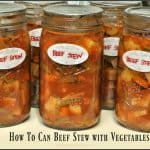
- 1 Tablespoon vegetable oil
- 2½ pounds stewing beef , cut into 1½ inch cubes
- 6 cups potatoes , peeled and cubed
- 4 cups carrots , peeled and sliced
- 1½ cups chopped celery
- 1½ cups chopped onions
- 2 cans (11.5 ounce each) diced tomatoes
- 1 can green beans (11.5 ounce)
- 1 beef bouillon cube (large)
- 2½ teaspoons salt
- 1/2 teaspoon dried thyme
- 1/2 teaspoon dried oregano
- 1/2 teaspoon black pepper
- 1 1/2 teaspoon minced garlic
- Boiling water (enough to cover)
- Prepare pressure canner, canning jars and lids, according to manufacturer instructions and general canning guidelines.
- Heat oil in large skillet (or very large saucepan) on medium-high. Brown the beef cubes (work in batches, if necessary). Only add additional oil if absolutely necessary.
- Place the browned beef into a very large saucepan; add potatoes, celery, carrots, onions, canned tomatoes, green beans, beef bouillon cube, and remaining spices. Stir to combine. Add boiling water to completely cover the ingredients. Bring the stew to a boil, while continuing to stir.
- Ladle the hot stew into hot canning jars. Be sure to leave a 1 inch headspace. Remove the air bubbles from each jar, then adjust the headspace by adding or removing stew, as necessary. Wipe the rims of each jar very well with a wet paper towel, to remove any trace of food or liquid. Place a heated flat lid on top, then screw the band down until it is fingertip tight.
- Carefully place the jars into prepared pressure canner. Lock the lid, then turn heat to medium high heat. Once it boils, vent the steam for 10 minutes, then close the vent. Continue to heat until canner reaches 10 pounds pressure. Process Quart jars for 90 minutes (If using pint jars, they need to be processed for 75 minutes).
- Once processing is completed, turn the heat off. Let the pressure return to zero naturally. Wait a few more minutes after if reaches zero, then open the vent cover. Remove the canner lid carefully (away from you). Let sit uncovered for 10 minutes, then carefully remove boiling hot jars to a dish towel. (Don't place boiling hot jars directly on counter as they might crack from temperature variance). Let jars cool completely, label and store in pantry.
Pint jars = 1 inch headspace. 75 minutes at 10# pressure = 10 jars
Quart jars = 1 inch headspace. 90 minutes at 10# pressure = 5 jars
Here’s one more to pin on your Pinterest boards!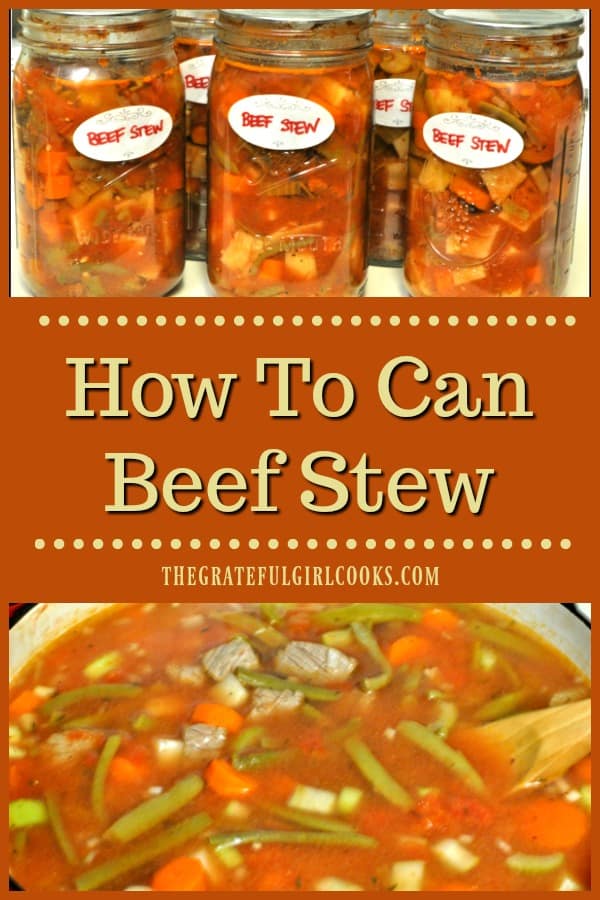

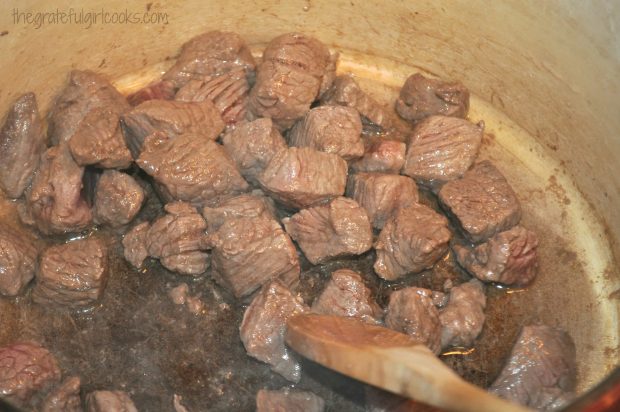
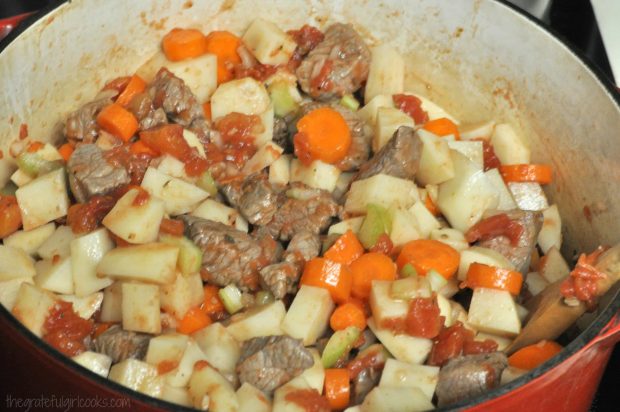
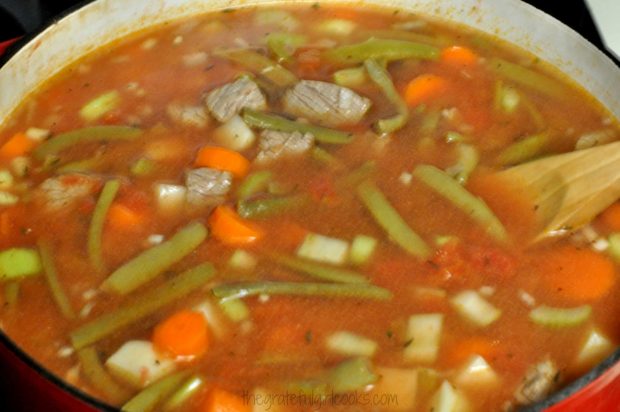
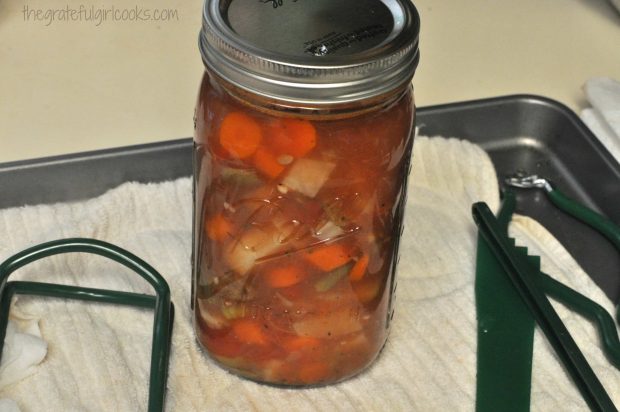
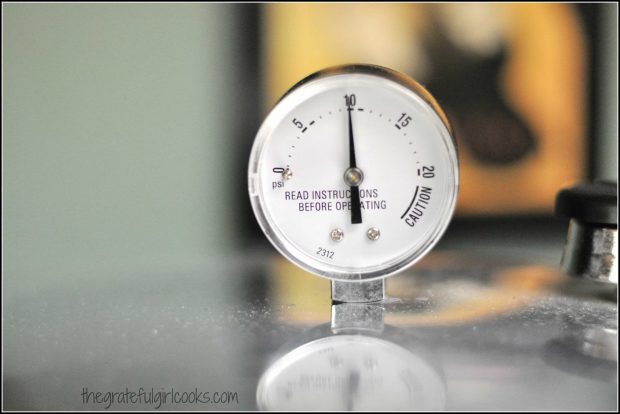
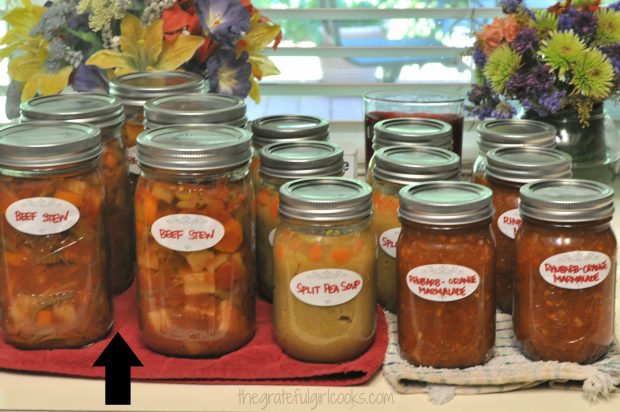

Has anyone had problems with bad smelling beef after it was canned? My beef stew was disappointing because the beef chunks smelled like cat food! The jars looked great but the beef odor was a turnoff and the stew went to the garbage disposal. A huge waste of time, money, and food. Any remedy for thus problem is appreciated.
If I don’t want to use “canned” green beans what are my options for using fresh green beans. First time learning a pressure cooker so a little bit skittish.
Do you add more seasoning to the stew after you open it to eat?
Only if you wish to, to suit your own personal taste, Shannon.
How much water do you put in the pressure canner.?. I’ve water bathed canned where you cover the jar but have never used pressure cooker.
Always follow the manufacturer instructions for how much water to add, as there are many sizes of pressure canners.
Why do you use green beans and tomatoes from a can? Doesn’t the canning process for the stew over cook them and turn them to mush?
Love my pressure canner and have canned lots of veggies and soups also potatoes, the squash I can is delicious in soup. Going to do your recipe. Thanks.
Isn’t it satisfying to can stuff that you have grown and prepared? I haven’t pressure canned for 30 years, so I needed a reminder. Thanks for the information and enthusiasm.
I use 15 lbs because I am at a high altitude. over 6000 ft.
Hi JB,
I just found your recipe and happen to notice in your ingredient list you have 2 1/2t. salt mentioned twice. Is that a typo or do you have 5t. salt?
Hi, Ken… Oh. My. Goodness. TOTAL typo, because I added it twice to the ingredient list. Thank you so very much for writing. I have updated the recipe card to reflect only 2.5 teaspoons salt used, and also recalculated the sodium content per serving. I appreciate your question. I can’t tell you how many times I look at a recipe ingredient list and that one completely slipped right by me… sigh. Have a great day!
Can you can a soup, if it has cheese in it?
Hi, Glenda. Everything I’ve ever read from canning books, articles, etc. says it is not a good idea, so I do not.
I would do this at 15 pounds, not 10. it’s thick stew and the pressure and heat need to penetrate.
Good afternoon, Freda! Thanks for taking the time to write. The temperature setting I use (10 lbs. pressure) has always worked perfectly and safely for me during numerous times canning many, many quarts of this beef stew. It is the recommended pressure setting in numerous online Pressure Canning Recipes, also. I based my recipe on a recipe found in the Ball Book of Complete Preserving, where their Beef Stew recipe (very similar in ingredients to mine) is cooked at 10 pounds pressure, as well. Have a wonderful day.
Can you can any left over beef stew with only carrots and potatoes. I always fix a whole big crock pot full and about the only thing I can eat I hate to waste it since I’m the only one who eats it !!!! I know how to can pickles and stuff from my garden. But since the beef stew is fully cooked ( all night long and half the next day ) can I do it the same way as all the other stuff I can. I have never used a canner or pressure cooker. Just a big cooker that I fill with water And make sure all my jars are boiled Then I fill the jars then put lids and seals on them and place back into a boiling cooker of water That has always worked for tomatoes cucumbers and any other garden foods. My grandmother never used a pressure cooker. She was always afraid of them. Ppl have been burnt and scaled from them. I have also heard of ppl canning soup beans Deer meat and lots more !!!
Hi, Nina. You know, I have never canned it with only the carrots and potatoes, so not sure how that would turn out. My personal recommendation is always to pressure can this recipe, because it is a low-acid dish (meat and vegetables). The high temperatures necessary to kill off any harmful bacteria present in low-acid food is achieved through pressure canning (which is super high heat). Thank you for writing!
I cooked a batch of stew with alot of leftovers. I canned the fully cooked stew in pressure cooker at 10 lbs pressure for 25 mins only. Now I’m worrying it wasnt long enough. Can you go back and do it again for more time with cooled jars? Or is this enough time maybe?
Is it possible to thosnold school by just placing in boiling water for 5minutes I don’t own a pressure cooker or canner is there a difference between the two?
Darlene… I am not sure I understand your question. Beef stew must be canned using a pressure canner, because it heats the food in the jar to such a high temperature it “kills off” any harmful bacteria and toxins that might be present.
Is there any place in Saskatoon that can teach me how to can property . Or any person can show me what to do. By canning foods for my family.
Good morning, Bev! I am not familiar with Saskatoon at all, so unfortunately cannot recommend any places that could teach you how to can. I can only suggest finding information online, or through books available at stores or libraries on the subject. For me, the way I learned was by starting with making jam. Then I bought a pressure canner and a couple good canning books (Ball Blue Book and Ball Complete Book of Home Preserving ), and taught myself (through trial and error) how to can green beans first. Once I was successful at that, I then gained the confidence to experiment with other recipes, and have never stopped since then. I hope you are successful in this venture! Have a great day, and thank you for writing!